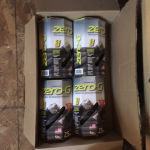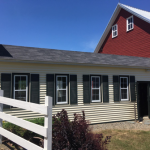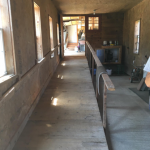Farmers with limitations offer their advice: “Try stuff”
By Ellen S. Gibson
Farming is hard work.
Physical limitations- whether from an injury, disability, or an aging body – can be challenging.
- How do you take care of your animals if you can’t lift a 50-pound grain bag?
- Get water to the garden if your mobility is limited?
- Put hay in the barn if you don’t have the physical endurance?
Farmers are inventive.
They like to do things for themselves. Take Liz DePoy and Stephen Gilson for example, they have been adapting and modifying Chapter Three Farm, where they care for rescue horses, for the past 25 years. DePoy and Gilson live with physical limitations. Gilson’s left hip is fused from a skiing accident and one leg is shorter than the other. DePoy has a congenital spine condition that limits her strength and mobility. With a goal of being able to care for the horses themselves, they look at what they need to do, think it through, and come up with some safe and reasonable solutions.
“It’s a learning curve,” said DePoy. “We try stuff. It doesn’t always work. We keep trying and adapting.”
Putting ideas into action.
 “I can’t lift anything,” said DePoy. She and Gilson installed an electric hoist in the loft. Now they can easily raise and lower items from the barn floor to the hayloft. Once they saw how well the hoist worked, they installed a second one at the other end of the barn.
“I can’t lift anything,” said DePoy. She and Gilson installed an electric hoist in the loft. Now they can easily raise and lower items from the barn floor to the hayloft. Once they saw how well the hoist worked, they installed a second one at the other end of the barn.

Keeping the main floor clear of extraneous equipment decreases danger from tripping. As people age and have limited mobility, tripping presents a serious hazard, which can result in injuries that take a long time to heal.
Multiple ways to get from here to there

There are two substantial, stationary ladders to get to the hayloft from the floor of the barn, one at each end of the barn. Having duplicates increases accessibility and conserves energy.

The safest way for DePoy to get into the haymow is up the stairs. But she likes the challenge of climbing the ladders at either end of the barn. “It’s good exercise,” she said. “Whether I can do it or not depends on how my body feels on a particular day.”
 Getting water to animals is always an issue. At Chapter Three Farm, the spigot was quite a distance from the stalls. The spigot is inside an insulated box so it won’t freeze in the winter. It’s heated with a lightbulb designed for reptile cages. A reel in the cabinet makes it easy to unwind the hose.
Getting water to animals is always an issue. At Chapter Three Farm, the spigot was quite a distance from the stalls. The spigot is inside an insulated box so it won’t freeze in the winter. It’s heated with a lightbulb designed for reptile cages. A reel in the cabinet makes it easy to unwind the hose.

DePoy uses a special hose, called Zero Gravity. This house is 50 percent lighter than a regular hose and it doesn’t kink.
 DePoy and Gilson built a covered walkway between the garage, which is attached to the house, and the barn. Now they don’t have to go outside to access the barn in the winter.
DePoy and Gilson built a covered walkway between the garage, which is attached to the house, and the barn. Now they don’t have to go outside to access the barn in the winter.

The barn is at a lower level than the house, and a ramp was built instead of stairs, which simplifies moving feed and other items from the garage to the barn. They use a collapsible marine cart to move things, like grain, from place to place. Designed to be exposed to salt spray from the ocean, it won’t rust and it has large wheels that don’t get caught in the cracks in the old barn floor. “We learned about wheels,” said DePoy. “They need to be big.”
Maine AgrAbility created a series of videos on AT used at Chapter Three Farm, the couple discusses many other tools and strategies they use on their farm to address physical limitations.
Thank you, Liz and Stephen, for sharing so many good ideas!
There’s much for farmers to learn from each other. What problems have you encountered and what solutions have you put in place? Email me at gellen2010@gmail.com and tell me the problem and how you addressed it to share on this blog. Thanks!
